
Astruc D. - Modern arene chemistry (2002)(en)
.pdf
|
|
|
References |
193 |
|
|
|
|
|
2 |
For a review, see: H. Fiege, K.-D. |
15 |
H. Hopf, A. Kru¨ger, Chem. Eur. J. 2001, |
|
|
Gundermann, C. Grundmann, in |
|
7, 4378–4385; cf. M. Prall, H. Hopf, P. |
|
|
Houben-Weyl-Mu¨ller, Methoden der |
|
Schreiner, A. Kru¨ger, Chem. Eur. J. |
|
|
Organischen Chemie, Vol. V/2b, Arene und |
|
2001, 7, 4386–4394. |
|
|
Arine, Thieme Verlag, Stuttgart, 1981, |
16 |
J. Hofmann, K. Schulz, A. Altman, M. |
|
|
pp. 41–87. |
|
Findeisen, G. Zimmermann, Liebigs |
|
3 |
W. Reppe, W. J. Schweckendieck, Liebigs |
|
Ann./Recueil 1997, 2541–2548; cf. K. |
|
|
Ann. Chem. 1948, 560, 104–116; cf. W. |
|
Schulz, J. Hofmann, G. Zimmermann, |
|
|
Reppe, Neue Entwicklungen auf dem Gebiet |
|
Eur. J. Org. Chem. 1998, 2135–2142. |
|
|
des Acetylens und Kohlenoxids, Springer |
17 |
R. F. C. Brown, F. W. Eastwood, K. J. |
|
|
Verlag, Heidelberg, 1949, and W. Reppe, |
|
Harrington, G. L. McMullen, Aust. J. |
|
|
Experientia 1949, 5, 93–110. |
|
Chem. 1974, 27, 2393–2402; cf. R. F. C. |
|
4 |
H. Hopf, plenary lecture at the Inter- |
|
Brown, F. W. Eastwood, G. P. Jackman, |
|
|
national Symposium of Novel Aromatic |
|
Aust. J. Chem. 1977, 30, 1757–1767. |
|
|
Systems (ISNA-9), Hong Kong, 1998. |
18 |
For a recent summary of the extensive |
|
5 |
For a summary, see: R. F. C. Brown, |
|
literature, see H. Hopf, Classics in |
|
|
Pyrolytic Methods in Organic Chemistry, |
|
Hydrocarbon Chemistry, Wiley-VCH, |
|
|
Academic Press, New York, 1980; cf. R. F. |
|
Weinheim, 2000, Ch. 12.2, pp. 330– |
|
|
C. Brown, Eur. J. Org. Chem. 1999, 3211– |
|
336. |
|
|
3222, and refs. cited therein. |
19 |
S. Hagen, H. Hopf, Top. Curr. Chem. |
|
6 |
H. Hopf, H. Musso, Angew. Chem. 1969, |
|
1998, 196, 45–89. |
|
|
81, 704; Angew. Chem. Int. Ed. Engl. 1969, |
20 |
L. T. Scott, M. M. Hashemi, D. T. |
|
|
8, 680. |
|
Meyer, H. B. Warren, J. Am. Chem. Soc. |
|
7 |
R. G. Bergman, Acc. Chem. Res. 1973, 6, |
|
1991, 113, 7082–7084; cf. L. T. Scott, Pure |
|
|
25–31. |
|
Appl. Chem. 1996, 68, 291–300 and refs. |
|
8 |
For the determination of the activation |
|
cited therein. |
|
|
parameters of the Bergman and related |
21 |
P. W. Rabideau, A. H. Abdourazak, |
|
|
processes, see W. R. Roth, H. Hopf, C. |
|
H. E. Folsom, Z. Marzinow, A. Sygula, |
|
|
Horn, Chem. Ber. 1994, 127, 1765– |
|
R. J. Sygula, J. Am. Chem. Soc. 1994, 116, |
|
|
1779. |
|
7891–7892. |
|
9 |
For a recent review, see: G. Zimmermann, |
22 |
M. Matsuda, H. Matsubara, M. Sato, S. |
|
|
Eur. J. Org. Chem. 2001, 457–471. |
|
Okamoto, K. Yamamoto, Chem. Lett. |
|
10 |
For the first preparation of isobenzene, |
|
1996, 157–158. |
|
|
see: M. Christl, M. Braun, G. Mu¨ller, |
23 |
G. Zimmermann, U. Nu¨chter, S. Hagen, |
|
|
Angew. Chem. 1992, 104, 471–473; Angew. |
|
M. Nu¨chter, Tetrahedron Lett. 1994, 35, |
|
|
Chem. Int. Ed. Engl. 1992, 31, 473–475; cf. |
|
4747–4750. |
|
|
M. Christl, S. Groetsch, Eur. J. Org. |
24 |
C. Glaser, Ber. Dtsch. Chem. Ges. 1869, 2, |
|
|
Chem. 2000, 1871–1874. |
|
422–424. |
|
11 |
H. Hopf, H. Berger, G. Zimmermann, |
25 |
G. Eglinton, A. R. Galbraith, Chem. |
|
|
U. Nu¨chter, P. G. Jones, I. Dix, Angew. |
|
Ind. (London) 1956, 737–738; cf. G. |
|
|
Chem. 1997, 109, 1236–1238; Angew. |
|
Eglinton, A. R. Galbraith, J. Chem. Soc. |
|
|
Chem. Int. Ed. Engl. 1997, 36, 1187–1190. |
|
1959, 889–896. |
|
12 |
H. Berger, planned Ph.D. dissertation, |
26 |
A. S. Hay, J. Org. Chem. 1962, 27, 3320– |
|
|
Braunschweig, 2002. |
|
3321. |
|
13 |
1,2-Bismethylenecyclobutanes are |
27 |
W. Chodkiewicz, P. Cadiot, Compt. |
|
|
commonly observed dimerization products |
|
Rend. 1955, 241, 1055; cf. W. |
|
|
of acyclic and cyclic allenes: H. Hopf, in |
|
Chodkiewicz, Ann. Chim. 1957, 2, 819– |
|
|
The Chemistry of the Allenes (Ed.: S. R. |
|
869 and P. Cadiot, W. Chodkiewicz, in |
|
|
Landor) Academic Press, London, 1982, |
|
The Chemistry of Acetylenes (Ed.: H. G. |
|
|
pp. 525–562. |
|
Viehe), Marcel Dekker, New York, 1969, |
|
14 |
H. Meier, N. Hanold, H. Kolshorn, |
|
Chapter 9, pp. 597–647. |
|
|
Angew. Chem. 1982, 94, 67–68; Angew. |
28 |
C. E. Stephens, R. D. Castro, J. Org. |
|
|
Chem. Int. Ed. Engl. 1982, 21, 66–67; cf. N. |
|
Chem. 1963, 28, 2163; for a review, see A. |
|
|
Hanold, H. Meier, Chem. Ber. 1985, 118, |
|
M. Sladkov, I. R. Gol’ding, Russ. Chem. |
|
|
198–209. |
|
Rev. 1979, 48, 868–896. |
|

194 5 From Acetylenes to Aromatics: Novel Routes -- Novel Products
29For a recent review, see: A. de Meijere,
F.E. Meyer, Angew. Chem. 1994, 106, 2473–2506; Angew. Chem. Int. Ed. Engl.
1994, 33, 1943–1962.
30K. Sonogashira, Y. Tohda, N. Hagihara, Tetrahedron Lett. 1975, 4467– 4470; cf. K. Sonogashira, Comprehensive Organic Synthesis, Vol. 3, Pergamon Press, Oxford, 1990, pp. 521–549, and K. Mu¨llen, S. Valiyaveetil, V. Francke,
V.S. Iyer, in Molecular Wires, NATO-AST Series, Kluwer Int. Press, 1997.
31F. Diederich, P. J. Stang (Eds.), MetalCatalyzed Cross-Coupling Reactions, WileyVCH, Weinheim, 1998.
32R. Diercks, J. D. Armstrong, R. Boese,
K.P. C. Vollhardt, Angew. Chem. 1986,
98, 270–271; Angew. Chem. Int. Ed. Engl.
1986, 25, 268–269.
33K. Sanechika, T. Yamamoto, A. Yamamoto, Bull. Chem. Soc. Jpn. 1984, 57, 752–755; cf. M. E. Wright,
Macromolecules 1989, 22, 3256–3259.
34Reviews: J. K. Young, J. S. Moore, in
Modern Acetylene Chemistry (Eds.: P. J. Stang, F. Diederich), VCH Verlagsgesellschaft, Weinheim, 1995, pp. 415–442; J. F. Moore, Acc. Chem. Res.
1997, 30, 402–413.
35R. H. Grubbs, D. Kratz, Chem. Ber. 1993,
126, 149–157.
36R. Boese, J. R. Green, J. Mittendorf,
D.L. Mohler, K. P. C. Vollhardt, Angew. Chem. 1992, 104, 1643–1645; Angew. Chem. Int. Ed. Engl. 1992, 31, 1643–1645.
37M. M. Haley, J. J. Pak, S. C. Brand, Top. Curr. Chem. 1999, 201, 81–130.
38G. Eglinton, A. R. Galbraith, Proc. Chem. Soc. 1957, 350; cf. O. M. Behr, G. Eglinton, A. R. Galbraith, R. A. Raphael, J. Chem. Soc. 1960, 3614–3625.
39Q. Zhou, P. J. Carroll, T. M. Swager, J. Org. Chem. 1994, 59, 1294–1301.
40M. M. Haley, W. B. Wan, in Advances in Strained and Interesting Organic Molecules
(Ed.: B. Halton), JAI Press, Inc., Stamford, CT, 2000, pp. 1–41.
41M. L. Bell, R. C. Chiechi, C. A. Johnson, D. B. Kimball, A. J. Matzger,
W.B. Wan, T. J. R. Weakley, M. M. Haley, Tetrahedron 2001, 57, 3507–3520.
42W. B. Wan, S. C. Brand, J. J. Pak, M. M. Haley, Chem. Eur. J. 2000, 6, 2044– 2052.
43W. B. Wan, M. M. Haley, J. Org. Chem.
2001, 66, 3893–3901.
44J. D. Tovar, N. Jux, T. Jarrosson, S. I. Khan, Y. Rubin, J. Org. Chem. 1997, 62, 3422–3433.
45W. B. Wan, R. C. Chiechi, T. J. R. Weakley, M. M. Haley, Eur. J. Org. Chem. 2001, 3487–3490; cf. A. J. Boydston, M.
M.Haley, Org. Lett. 2001, 3, 3599–3601.
46J. J. Pak, T. J. R. Weakley, M. M. Haley,
J.Am. Chem. Soc. 1999, 121, 8182–8192.
47A. Sarkar, M. M. Haley, Chem. Commun.
2000, 1733–1734.
48J. R. Fritch, K. P. C. Vollhardt,
Organometallics 1982, 1, 590–602.
49M. Laskoski, M. D. Smith, J. G. M. Morton, U. H. F. Bunz, J. Org. Chem.
2001, 66, 5174–5181.
50M. Laskoski, G. Roidl, M. D. Smith,
U.H. F. Bunz, Angew. Chem. 2001, 113, 1508–1511; Angew. Chem. Int. Ed. 2001, 1460–1463.
51M. Laskoski, W. Steffen, M. D. Smith,
U.H. F. Bunz, Chem. Commun. 2001, 691–692.
52J. M. Hunter, J. L. Fye, E. J. Roskamp,
M.F. Jarrold, J. Phys. Chem. 1994, 98, 1810–1818.
53K. P. C. Vollhardt, Angew. Chem. 1984,
96, 525–541; Angew. Chem. Int. Ed. Engl.
1984, 23, 539–555; cf. N. E. Schore,
Chem. Rev. 1988, 88, 1081–1119.
54K. P. C. Vollhardt, D. L. Mohler, in
Advances in Strain in Organic Chemistry
(Ed.: B. Halton), JAI Press, Inc., Greenwich, CT, Vol. V, 1996, 121–160.
55B. C. Berris, G. H. Hovakeemian, Y.-H. Lai, H. Mestdagh, K. P. C. Vollhardt, J. Am. Chem. Soc. 1985, 107, 5670–5687; cf.
R.L. Funk, K. P. C. Vollhardt, J. Am. Chem. Soc. 1980, 102, 5253–5261.
56R. Boese, A. J. Matzger, D. L. Mohler,
K.P. C. Vollhardt, Angew. Chem. 1995,
107, 1630–1633; Angew. Chem. Int. Ed. Engl. 1995, 34, 1478–1481 and refs. cited therein.
57N. L. Frank, K. K. Baldridge, J. J. Siegel, J. Am. Chem. Soc. 1995, 117, 2102–2103.
58Review: K. C. Nicolaou, A. L. Smith, in
Modern Acetylene Chemistry (Eds.: P. J. Stang, F. Diederich), VCH Verlagsgesellschaft, Weinheim, 1995, pp. 203–283.
|
|
|
References |
195 |
|
|
|
|
|
59 |
K. K. Wang, Chem. Rev. 1996, 96, 207– |
|
Macromol. Rapid Commun. 1998, 19, 441– |
|
|
222. |
|
444. |
|
60 |
J. W. Grissom, G. U. Gunawardena, D. |
71 |
H. Hopf, C. Werner, P. G. Jones, P. |
|
|
Klingberg, D. H. Huang, Tetrahedron |
|
Bubenitschek, Angew. Chem. 1995, 107, |
|
|
1996, 52, 6453–6518. |
|
2592–2594; Angew. Chem. Int. Ed. Engl. |
|
61 |
D. M. Bowles, G. J. Palmer, C. A. Landis, |
|
1995, 34, 2367–2368. |
|
|
J. L. Scott, J. E. Anthony, Tetrahedron |
72 |
H. Sato, N. Isono, K. Okamura, T. Date, |
|
|
2001, 57, 3753–3760. |
|
M. Mori, Tetrahedron Lett. 1994, 35, 2035– |
|
62 |
D. J. Cram, J. M. Cram, Acc. Chem. Res. |
|
2038. |
|
|
1971, 4, 204–213. |
73 |
Review: M. Mori, N. Isono, H. |
|
63 |
D. J. Cram, J. M. Cram, Container |
|
Wakamatsu, Synlett 1999, 269–280. |
|
|
Molecules and Their Guests, Royal Society of |
74 |
H. Hopf, Chr. Werner, Eur. J. Org. |
|
|
Chemistry, London, 1992. |
|
Chem., in preparation. |
|
64 |
P. M. Keehn, S. M. Rosenfeld (Eds.), |
75 |
F. Sondheimer, R. Wolovsky, J. Am. |
|
|
Cyclophanes I and II, Academic Press, New |
|
Chem. Soc. 1962, 84, 260–269; cf. F. |
|
|
York, N.Y., 1983. |
|
Sondheimer, Acc. Chem. Res. 1972, 5, 81– |
|
65 |
F. Diederich, Cyclophanes, Royal Society |
|
91. |
|
|
of Chemistry, London, 1991. |
76 |
A. J. Boydston, L. Bondarenko, I. Dix, |
|
66 |
F. Vo¨gtle, Cyclophane Chemistry, J. Wiley |
|
T. J. R. Weakley, H. Hopf, M. M. Haley, |
|
|
and Sons, Chichester, 1993. |
|
Angew. Chem. 2001, 113, 3074–3077; |
|
67 |
G. J. Bodwell, Angew. Chem. 1996, 108, |
|
Angew. Chem. Int. Ed. 2001, 40, 2986–2989. |
|
|
2221–2224; Angew. Chem. Int. Ed. Engl. |
77 |
Y. Rubin, T. C. Parker, S. I. Khan, C. L. |
|
|
1996, 35, 2085–2088; cf. A. de Meijere, B. |
|
Holliman, S. W. McElvany, J. Am. Chem. |
|
|
Ko¨nig, Synlett 1997, 1221–1232. |
|
Soc. 1996, 118, 5308–5309; cf. Y. Rubin, |
|
68 |
For a recent summary of pertinent |
|
Chem. Eur. J. 1997, 3, 1009–1016. |
|
|
references, see: V. Rozenberg, T. |
78 |
Y. Tobe, N. Nakagawa, J. Kishi, M. |
|
|
Danilova, E. Sergeeva, E. Vorontsov, Z. |
|
Sonoda, K. Naemura, T. Wakabayashi, |
|
|
Starikova, A. Korlyukov, H. Hopf, Eur. |
|
T. Shida, Y. Achiba, Tetrahedron 2001, 57, |
|
|
J. Org. Chem. 2002, 468–477. |
|
3629–3636. |
|
69 |
H. Hopf, V. Rozenberg, L. Popova, Helv. |
79 |
W. Kra¨tschmer, L. D. Lamb, K. |
|
|
Chim. Acta 2002, 85, 431–441. |
|
Fostiropolous, R. D. Huffman, Nature |
|
70 |
J. Lahann, H. Ho¨cker, R. Langer, |
|
1990, 347, 354–358. |
|
|
Angew. Chem. 2001, 113, 746–749, |
80 |
H. Hopf, M. Psiorz, Angew. Chem. 1982, |
|
|
Angew. Chem. Int. Ed. 2001, 40, 726–728; |
|
94, 639–640; Angew. Chem. Int. Ed. Engl. |
|
|
cf. J. Lahann, D. Klee, H. Ho¨cker, |
|
1982, 21, 623–624. |
|

196
6
Functional Conjugated Materials for Optonics and Electronics by Tetraethynylethene Molecular Sca olding
Mogens Brøndsted Nielsen and Francois Diederich
Abstract
The physical properties of sca olds based on tetraethynylethene (TEE; 3,4-diethynylhex- 3-ene-1,5-diyne) are strongly enhanced by arylation. Indeed, owing to the coplanarity of anilino-substituted TEE sca olds, very high third-order optical nonlinearities are obtained. Moreover, arylated TEEs are able to undergo photochemically induced cis-trans isomerization, paving the way for applications as light-driven molecular switches in optoelectronic devices. Suitably functionalized TEE modules are readily incorporated into linear and cyclic p-conjugated sca olds, employing stepwise acetylenic coupling protocols. Thus, TEE molecular sca olding has provided access to large, macrocyclic, all-carbon cores and long poly(triacetylene) (PTA) oligomers.
6.1
Introduction
Acetylenic sca olding [1] of derivatized tetraethynylethenes (TEE; 3,4-diethynylhex-3-ene- 1,5-diyne; Figure 1) has provided access to advanced materials for electronic and photonic applications, such as chromophores with high secondand third-order optical nonlinearities, molecular photochemical switches, large two-dimensional carbon cores, and linearly p- conjugated molecular rods [2]. The physical properties of these materials rely strongly on the presence of arene units. Indeed, the six potential two-dimensional conjugation pathways (Figure 1) within the TEE unit can be controlled by arylation, hence providing the functional properties of the molecules.
In this chapter, we demonstrate how aryl groups, of either electron-donating or -accepting nature, determine the properties of a number of linear and cyclic sca olds based on TEE. These sca olds have been assembled by employing a number of metal-catalyzed coupling reactions. Thus, arylated TEEs are readily prepared by Pd-catalyzed cross-coupling of arylacetylenes with vinylic dibromides under Sonogashira [3] conditions (Scheme 1). Synthetic strategies developed during the last ten years have allowed access to TEEs with almost any desired substitution pattern about the central ten-carbon core. These methods have been covered in some recent review articles [4].
The construction of conjugated advanced materials based on functionalized TEE mono-
Modern Arene Chemistry. Edited by Didier Astruc
Copyright 8 2002 WILEY-VCH Verlag GmbH & Co. KGaA, Weinheim ISBN: 3-527-30489-4

6.1 Introduction 197
Fig. 1. Schematic representation of the possible conjugation pathways in perarylated TEEs. Paths a and b depict transand cis-linear conjugation, whereas path c depicts geminal cross-conjugation.
D ¼ electron donor, A ¼ electron acceptor.
Scheme 1. Synthesis of geminally bis-arylated TEEs [4].
mer units proceeds by oxidative acetylenic coupling [1f ], according to the protocol discovered by Glaser [5] in 1869, and modified procedures, such as the Eglinton [6] and Hay [7] variants for homo-coupling and the Cadiot–Chodkiewicz [8] variant for hetero-coupling (Scheme 2).
Scheme 2. Acetylenic coupling reactions [1f, 5–8]. TMEDA ¼ N,N,N0,N0-tetramethylethylenediamine.
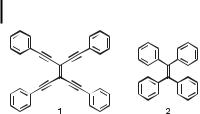
198 6 Functional Conjugated Materials for Optonics and Electronics by Tetraethynylethene Molecular Scaffolding
Fig. 2. The phenyl-substituted TEE 1 is planar in contrast to 2 [9, 10].
6.2
Arylated Tetraethynylethenes
The unique TEE framework facilitates p-conjugation with pendant aromatic substituents by allowing coplanar orientation throughout the molecular core, as was first witnessed in the X- ray crystal structure of tetrakis(phenylethynyl)ethene 1 determined by Hopf and co-workers [9]. In contrast, coplanarity is prevented by steric interactions in molecules such as cisstilbenes or tetraphenylethene 2 [10] (Figure 2). The planarity makes it possible for 1 to form highly ordered 1:2 stoichiometric donor–acceptor p-complexes in the solid state with electron-deficient molecules such as 2,4,7-trinitrofluoren-9-one and (2,4,7-trinitrofluoren-9- ylidene)malonitrile [11]. In solution, relatively weak 1:1 complexes with each of these two acceptors are formed, with association constants of 7.9 m 1 and 31.5 m 1, respectively, at 300 K in CDCl3.
The coplanarity has endowed arylated TEEs with some of the highest known third-order optical nonlinearities and, in the case of acentricity, also very large second-order nonlinear optical e ects. Furthermore, the strain-free planarity allows cisand trans-arylated TEEs to interconvert upon photochemical excitation without competition from undesirable thermal isomerization.
6.2.1
Nonlinear Optical Properties
The development of highly active third-order nonlinear optical (NLO) materials is important for all-optical signal processing. A comprehensive study by Gu¨nter, Bosshard, and co-workers [12] on the NLO properties of derivatized TEEs established useful structure– property relationships and provided insight into routes leading to desired optical nonlinearities. The following fundamental conclusions were drawn by comparison of compounds 3–11 depicted in Figure 3: (i) Donor substitution (e.g. with N,N-dimethylanilino) gives higher second hyperpolarizabilities (g) than acceptor substitution (4-nitrophenyl) (trans-6 versus trans-4), and the magnitude of g increases with donor strength (7 versus 5). Similar increases in g as a result of increased electron density have been observed in onedimensional systems such as stilbenes [13], polyenes [14], as well as various carotenoid systems [15]. (ii) Acentricity leads to larger g values (trans-9 versus trans-8). The significance of asymmetry in third-order NLO chromophores was initially postulated by Garito et al. [16], and this prediction has been confirmed experimentally for other linearly conjugated molecules [14, 17]. (iii) TEEs with donor and acceptor groups in trans or cis configurations exhibit much higher nonlinearities on account of favorable linear donor–acceptor conjugation (routes a and b in Figure 1) than TEEs with substituents in a geminal configuration, in
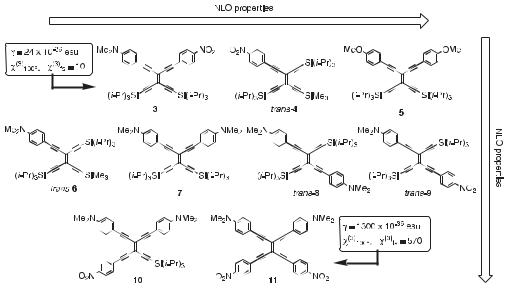
6.2 Arylated Tetraethynylethenes |
199 |
|
|
Fig. 3. The second hyperpolarizability g and thirdorder nonlinear optical susceptibility wð3Þ
increase in the sequence from 3 to 11 [12a]. The values given for 3 and 11 were determined under non-resonant conditions by third-harmonic genera-
tion experiments at a laser wavelength of 1.907 mm (third-harmonic wavelength 636 nm). wð3Þ was measured relative to wð3Þ of fused silica (fs) [12g], for which a value of wð3Þfs ¼ 1:16 10 14 esu was used (adjusted value relative to ref. [12a]).
which only the weaker cross-conjugation is e ective (route c in Figure 1) (trans-8 versus 7, trans-9 versus 3). (iv) A substantial increase in g is observed upon extending the conjugation length (as in TEE dimers, vide infra). (v) Full, two-dimensional conjugation with as many as six conjugation pathways leads to very large g values (11).
Since benzenoid aromaticity is reduced in thiophene as compared to benzene, thiophene exhibits an increased capacity to transmit linear p-electron conjugation, which can lead to an enhanced NLO response. This capacity has been demonstrated theoretically [18] and experimentally for both second- [19] and third-order [20] NLO e ects. Replacement of one 4- nitrophenyl ring in 11 by a 5-nitro-2-thienyl moiety leads to an increase in g by a factor of 1.3, as revealed by third-harmonic generation measurements at a laser wavelength of 2.1 mm (third-harmonic wavelength 700 nm) [12e]. However, this enhancement is more a result of the lowered molecular symmetry than of the nitrothienyl group itself, since substituting both nitrophenyl groups only increases g by a factor of 1.1. Thus, within the uncertainty of the measurements, g remains essentially unchanged when both nitrophenyl groups in 11 are replaced.
6.2.2
Photochemically Controlled cis–trans Isomerization: Molecular Switches
One very interesting property of arylated TEEs is their ability to undergo reversible, photochemical cis-trans isomerization [21], a property that is not exhibited by the non-arylated derivatives. The trans-to-cis isomerization is of preparative use for the synthesis of cis-TEEs that
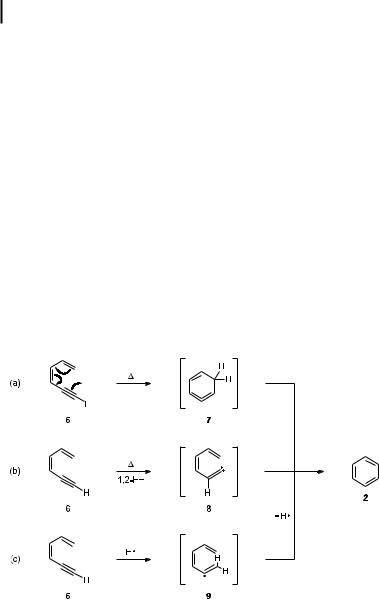
2006 Functional Conjugated Materials for Optonics and Electronics by Tetraethynylethene Molecular Scaffolding
are otherwise di cult to prepare. For example, trans-9 is converted to its cis isomer (37 % yield) by irradiation at 366 nm [22]. Moreover, the isomerization process has been employed for the construction of light-driven molecular switches [23]. Recently, the complex, highly programmed system trans-12a (Scheme 3) was developed, combining the cis/ trans-isomerizable TEE unit with two other addressable subunits, a photoswitchable dihydroazulene (DHA)/vinylheptafulvene (VHF) moiety, and a proton-sensitive dimethylaniline (DMA) group [23a, 23c]. This three-way chromophoric molecular switch is, in principle, able to perform individual, reversible switching cycles between as many as eight states. DHA derivatives are known to undergo, upon light irradiation, a 10-electron retro-electrocyclization to the isomeric VHF compounds [24], which, in turn, undergo a thermal cyclization back to the DHA forms. However, this switching capacity of the DHA chromophore is a ected when it is incorporated into the TEE derivative trans-12a. Thus, irradiation of trans-12a results only in reversible trans–cis isomerization of the TEE core, leaving the DHA moiety unchanged. On the other hand, protonation of the third subunit, the DMA substituent, triggers the DHA ! VHF photoreaction. Indeed, irradiation of the protonated species trans-12b causes retro-electrocyclization to trans-12c, which can thermally cyclize back to trans-12b. Clean isobestic points in the UV/vis spectra imply that only this DHF/VHF equilibrium is operative, which can be explained by the fact that the TEE trans–cis isomerization process is much
Scheme 3. ‘‘Three-dimensional’’ switching diagram of TEE-DHA-DMA hybrid derivative trans-12a, a three-way chromophoric molecular switch. Six out of eight possible states can be attained [23c].
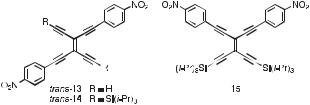
6.2 Arylated Tetraethynylethenes |
201 |
|
|
slower. Deprotonation of trans-12c by triethylamine does not o er a route to trans-12d, but is accompanied by retro-electrocyclization to trans-12a. Thus, the non-protonated VHFcontaining conjugate trans-12d (as well as the VHF isomer cis-12d) cannot be reached in the three-dimensional switching diagram. Consequently, of the eight potential states of 12, six are accessible and can be individually addressed by the various switching modes.
The failure of photochemical DHA ! VHF isomerization in trans-12a was rationalized through a joint experimental and computational study by Lu¨thi and co-workers [25]. The neutral conjugate showed a strong fluorescence emission that almost completely disappeared after protonation to trans-12b. The maximum of this intense emission was found to be strongly dependent on solvent polarity, and in hexane a dual fluorescence (lmax ¼ 505 and 541 nm; lexc ¼ 420 nm) was observed. In more polar solvents, such as CH2Cl2, the emission spectrum featured only a single, strongly red-shifted band (lmax ¼ 602 nm). Time-dependent density functional calculations on the excited state of related DMA-substituted TEEs suggested that the DHA ! VHF isomerization channel is quenched in trans-12a by an e cient relaxation of the vertically excited singlet state to an emitting twisted intramolecular chargetransfer (TICT) state [26], which would explain the experimentally observed dual fluorescence. In this lower-energy TICT state, either the dimethylamino group is twisted into an orthogonal position with respect to the planar arylated TEE moiety or the entire DMA group adopts an orthogonal orientation with respect to the TEE moiety. The calculations suggested that the twist of the dimethylamino group is more probable.
6.2.3
Electrochemically Controlled cis–trans Isomerization
A combined computational and electrochemical investigation revealed that arylated TEEs may also have potential as electrochemically driven molecular switches [27]. The electrochemical studies showed that the first reduction potentials of monoand bis(4-nitrophenyl)- substituted TEEs occur at similar values (around 1.35 to 1.38 V versus the ferrocene/ ferricinium couple, Fc/Fcþ) on steps involving one and two electrons, respectively. Moreover, the first reduction potential of nitrophenyl-substituted TEEs is hardly a ected by the presence of other aryl substituents, such as the DMA donor groups, attached to the TEE frame. These findings suggest that the nitrophenyl redox centers behave as independent redox centers. However, ab initio calculations on singly-reduced trans-13 (Figure 4)
Fig. 4. Bis(4-nitrophenyl)-substituted TEEs. The linear conjugation pathway between the two nitrophenyl groups makes the second oneelectron reduction of trans-14, generating the trianion, more di cult (by @80 mV) than for the geminally substituted 15 [27].
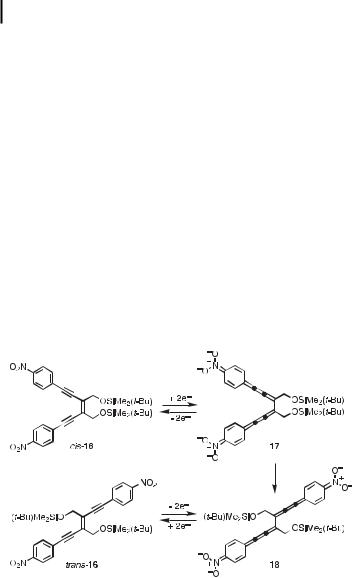
2026 Functional Conjugated Materials for Optonics and Electronics by Tetraethynylethene Molecular Scaffolding
suggested that the charge is actually localized on the TEE core. Indeed, the second reduction
of the Si(iPr)3-protected derivative of trans-13, that is trans-14, in which the two nitrophenyl groups are linearly conjugated, was found to be more di cult (by @80 mV) than that of the
geminally substituted, cross-conjugated TEE 15. Thus, charge delocalization into the TEE core of dianionic trans-14 augments the energetic requirements for the second reduction step forming the trianion. For the generated dianion of trans-14, linear delocalization results in a cumulenic/quinoid structure, in which the central TEE bond acquires significant singlebond character. This structure allows rotation about this central bond and hence isomerization. Spectroelectrochemical experiments on the cis-enediyne cis-16 o ered support for this theoretically predicted cumulenic-type intermediate, since it was found to isomerize irreversibly, via 17 and 18, to its trans isomer (Scheme 4). However, cis-16 can be photochemically regenerated, although the photoequilibrium only slightly favors it relative to trans-16 (Kphoto ¼ [cis]/[trans] ¼ 1:2 in n-hexane, 27 C, lexc ¼ 360 nm) [28]. Accordingly, cis/ trans-16 behaves as a molecular switch that is turned on (trans) by electrons and o (cis/trans
